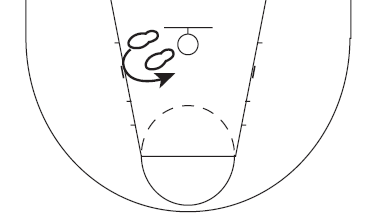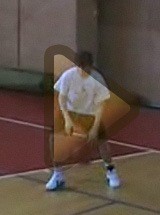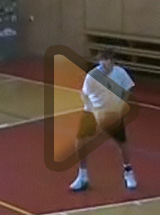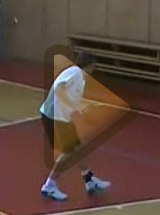Low a Mid
– Post Actions in the Paint
For complex capacity of players we recommend doing drives from the paint with all players; at the beginning we show methodology of actions connected from whole text of pivotman’s alphabet.
Training methodology
- Basic posture – down flexion and up-extension slows down the drive implementation
- Look at defender – his stance determines the following offensive´s actions
- Fake of backward pass
- Look at ball at the moment of drive
- Ball covering – ball positioned in bend arms from body at the level of shoulder
- When defender stands back choose shot after reverse or front turn (player should be able to do both and then choose by himself), connect by shot with offensive rebound. When turning, fake of throw with low gravity posture and at the moment defender gathers round choose drive according the rules for drives from outside of the paint.
- When tight defence, choose lay-up started back to the defender after one bounce together with step of pivot leg. Focus on practise of posture, speed, and contact with defender by other shoulder, cut tightly around the defender in the direction of basket (not to the side)
- Against good stance defender choose low dribbling between legs in order to create advantageous position for shot close to the basket (this position can be gained by backward pass and pushing to the defender) and choose shot according to defender´s posture (cross over, cross over step etc.)
- Dribbling with low number of bounces, prefer drive with two bounce´s dribbling
- Practise drive on the side of the weaker hand, variation of offenses is important, which leads to situation when defender does not know, if forward would shoot, do lay-up, turn etc.
- Practise creating good position for rebound just after shot, hold ball over hear after rebound in slightly bend arms with possibility of immediate hook shot after catching the ball – using good position created by struggling for position or height dominance over defender.
One-on-One (1/1) in the paint from the view of offensive player – Drives
Clearings with the ball before one-on-one player has to secure advantageous position for receiving the pass, movement against the pass and decision if the player would use fake together with spin connected with shot against the defender, one or two bounce dribbling together with some kind of technique from previous chapter; In this chapter we deal with analysis of individual drives (A–E).
- Hook shot after turnaround with one bounce dribbling and lay-up (Fig. 51) – player at the moment of dribbling do front-turn which is closer to the base line (presuming tight defence to the base line). The important moment is height of body gravity at the beginning of drive, his move to the close contact with defender´s hip, whip speed of turning and step length.
Drive methodology: emphasis on gravity level, whip speed to drive, contact to defender, ball position after one bounce low dribbling between feet, hook shot technique and rejection of blocking defender, prepare player for possible offensive rebound.
- Shot after turnaround with two bounce dribbling – taking advantage of defender standing back, attempt to get closer to the basket by dribbling (Fig. 52) and create better position for shot – many ways of shooting after jump shot – hook shot, fake of this shot and drop step, after spin – hook shot with block rejecting or after fade away by stop jump, after spin and shot with using throw fake.
Drive methodology: emphasis on dribbling between feet in low posture, head checking the area, body in contact with defender, length of step when turning and speed of drive in lower posture, not extending the gravity centre when faking but just put hands with ball up, check the stability of posture after drop step, prepare for offensive rebound.

Fig. 52: Two bounce dribbling drive
- Stop jump shot after turnaround – we recognise face-up and drop step turn (Fig. 53, 54), use of defender standing back
Drive methodology: during turn we put emphasis on low posture, not extending centre of gravity during fake, checking stability of posture, width and position of feet in the way to the basket, prepare for offensive rebound.
- Shot after turn, fake of stop jump and drop step.
Drive methodology: during turn put emphasis on step length and speed of action in low posture, not increasing centre of gravity during fake but just hands with ball, check stability of posture after drop step, emphasis on shot by hand which is farther from defender, prepare for offensive rebound.
- Shot after face up turnaround, fake of stop jump and then direct drive or crossover.
Drive methodology: during spin put emphasis on step length and speed in low posture, not increasing centre of gravity during fake but just hands with ball, check stability of posture after spin, emphasis on level of gravity, be aware of travel rule violation when starting the drive – emphasis on taking long, fast, dynamic first step, contact to the defender, position of ball after one low bounce dribbling behind the body – loose shoulder goes in a front, hook shot technique and rejection of blocking defender, emphasis on shot by hand which is farther from the defender, prepare for offensive rebound.
Mgr. Tomáš Pětivlas, Ph.D. |
Faculty of Sports Studies of Masaryk University |
back to homepage, accessability |
Faculty of Sports Studies of Masaryk University |
back to homepage, accessability |
| Technical cooperation:
| Service Center for E-Learning
| The Faculty of Informatics, Masaryk University, 2011
| Service Center for E-Learning
| The Faculty of Informatics, Masaryk University, 2011
Technické řešení této výukové pomůcky je spolufinancováno Evropským sociálním fondem a státním rozpočtem České republiky.




